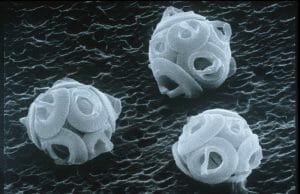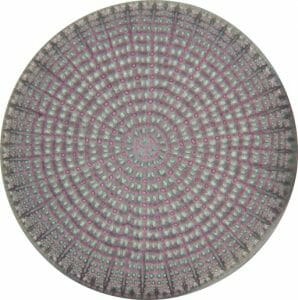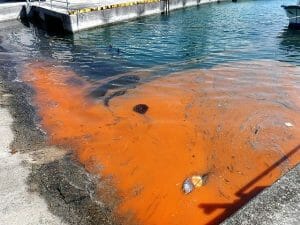Phytoplankton Definition
Phytoplankton are a type of microscopic plankton capable of photosynthesis found in oceans, seas, and freshwater, and an essential component of aquatic ecosystems. Phytoplankton can range in size and shape, and since they are photosynthesizing autotrophic organisms, they inhabit waters exposed to sunlight. Although each organism is microscopic, in sufficient numbers, phytoplankton can be observed as colored patches at the surface of bodies of water, or where two currents meet, due to the presence of chlorophyll. Phytoplankton are often cultured to support aquaculture, and are critical for controlling carbon dioxide and oxygen levels in the Earth’s atmosphere since the Precambrian Era. Indeed, it is estimated that phytoplankton are responsible for as much as 85% of the oxygen in the atmosphere.
Phytoplankton Examples
Since the term phytoplankton encompasses a wide variety of different photosynthesizing aquatic microorganisms (over 5000 species recorded), different species are found in each specific environment. Examples of some of the most commonly studied species are described below:
Coccolithophorids
Coccolithophorids are an important species of phytoplankton that exhibit characteristic calcium carbonate plates known as coccoliths (shown below). Although this type of phytoplankton is an important microfossil, it is also a source of dimethyl sulfide, which is thought to represent a potential mechanism by which to regulate climate change. It is thought that by increasing the number of these phytoplankton, the enhanced level of dimethyl sulfide will become oxidized, forming sulfur dioxide and sulfate aerosols. These aerosols will function as cloud seed nuclei that will increase cloud coverage and the reflection of sunlight.
Cyanobacteria
Cyanobacteria (pictured below) are extremely small phytoplankton that typically inhabit less turbulent waters and can thrive in environments where there are fewer nutrients available. Cyanobacterial species are highly diverse and have been shown to be extremely tolerant to changes in aquatic conditions, thus outcompeting many other types of phytoplankton when water temperatures change or nutrients become less abundant.
Diatoms
Diatoms (image seen below) are an extremely important phytoplankton that while microscopic, replicate rapidly. Diatoms can be used as an indication of water quality, as they follow a “bloom-and-bust” life cycle. As nutrients reach the sunlight surfaces of an ocean, diatoms rapidly reproduce. When the nutrients are depleted (i.e., silicon), this growth ceases. Diatoms also comprise a substantial portion of the organic matter found in the sediment of large bodies of water.
Dinoflagellates
Dinoflagellates are an important phytoplankton typically involved in supporting coral reef ecosystems as a significant food source for many species. Dinoflagellates are known to cause harmful algae blooms exhibiting a characteristic red color, termed “red tide” (shown below). Such blooms have been known to contaminate shellfish, which will cause food poisoning in humans, if consumed.
What Do Phytoplankton Eat?
Phytoplankton are primarily dependant on minerals found in aquatic environments and Vitamin B to survive. For aquatic environments to support phytoplankton, the presence of iron, phosphate, silicic acid, and nitrate are required. Indeed, when there is a deficiency in these macronutrients, there is a corresponding absence of phytoplankton.
Quiz
1. The absence of phytoplankton in an aquatic environment is an indication of:
A. Water quality
B. The absence of sunlight
C. Insufficient nutrients
D. All of the above are indications
2. Which of the following statements about phytoplankton is TRUE?
A. Phytoplankton is responsible for as much as 85% of the atmospheric oxygen found on Earth.
B. Vitamin B is toxic to phytoplankton.
C. All phytoplankton species cause blue algae blooms.
D. All of these statements are true.
3. “Red tide” is caused by what type of phytoplankton?
A. Coccolithophorids
B. Cyanobacteria
C. Dinoflagellates
D. Diatoms
References
- Benoiston et al. (2017). The evolution of diatoms and their biogeochemical functions. Philos Trans R Soc Lond B Biol Sci.372(1728):pii: 20160397.
- Helliwell, KE. (2017). The roles of B vitamins in phytoplankton nutrition: new perspectives and prospects. New Phytol. 216(1): 62-68.
- Tandon et al. (2017). A promising approach to enhance microalgae productivity by exogenous supply of vitamins. Microb Cell Fact. 16(1):219.
- Lee et al. (2017). The role of algae and cyanobacteria in the production and release of odorants in water. Environ Pollut. 227: 252-262.




